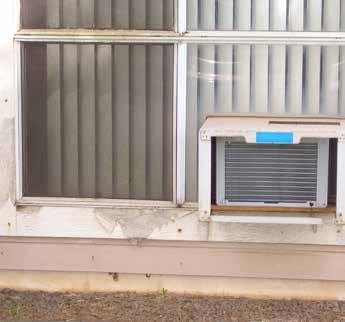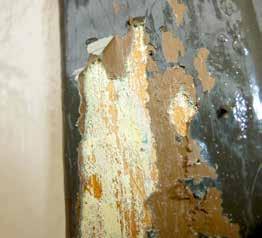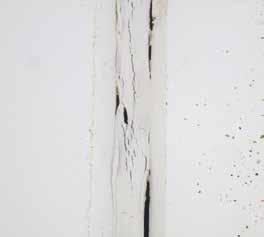
6 minute read
Joni McGinnis
Exterior Paint Solutions: The First Line of Defense Hawaii’s sun, salt and rain create a harsh environment for a building’s paint, requiring regular maintenance
JONI MCGINNIS
Advertisement
Exterior painting is a decision all property owners will sooner or later need to address to maintain the property’s value. Paint is the first line of defense protecting the exterior surfaces from the harsh elements while also adding aesthetic curb appeal value. Hawaii’s rigorous climate with its high U.V. levels within a marine environment demands a high degree of protection. Choosing a high-quality premium paint will typically yield a paint life- cycle of around seven to 10 years.
Exterior paint is constantly deteriorating through the process of weathering, but in a program of regular maintenance—assuming all other building properties are functioning properly—the surface preparation for a new finish coat can be limited to minor repairs and cleaning. Unfortunately,
Wooster Products Inc. Making every step a safe one!
Stairmaster ® Safety Treads
® Stairmaster Safety Renovation Treads:
● Designed for the moderization and restoration of all stair types
● High quality to assure long tread life under heavy pedestrian traffic











● Durable and long lasting treads for both indoor and outdoor use
Wooster Products Inc. Anti-slip safety stair and walkway products For more information contact us today! woosterproducts.com | 800-321-4936

if the paint film has gone beyond its life cycle and surfaces have not been maintained, surface preparation will become more detailed and will most likely increase the cost of a painting project.
As a specification writer, my objective is to identify for building owners and managers the requirements for surface preparation, coating application, the materials to be applied and the expectations for quality control and documentation. Typically, a meeting is scheduled with the property owner or manager to discuss subjects such as existing problems, color changes, scheduling and other maintenance issues. A property site inspection is then scheduled and a draft specification would follow for review. The final specification is then issued to the property owner/manager to be used as a basis for proposals.
The property inspection along with the maintenance history is the basis for the specification. There are common problems to expect from weathering and exposure to the elements, such as environmental grime and organic matter that tends to cling to painted surfaces. Accessing the existing surface is critical for the success of the painting project. Some conditions are easily identified while others are hidden, only to be discovered during the paint application. Here are four trouble areas that may be problematic if not addressed properly.
Too many layers of paint
Excessive layers of paint may appear sound and adequately adhered to the substrate prior to repainting, but problems can arise once the new coating is applied. The most common are lifting, blistering or peeling. When this problem occurs, the easiest target is to blame the new paint finish as being the culprit, but it could be the result of too many layers of paint. There is a limit to the number of coats of paint that a surface can support. As paint thickness builds from past maintenance cycles, the film is no longer flexible. This could lead to problems when the substrate expands and contracts but the paint film is no longer flexible to move with the surface. Cracking or flaking of the coating usually results. When a new coat of paint is applied, it shrinks during the curing process, exerting stress on the existing film. If the existing finish has weak points such as cracks or voids, this stress will cause the poorly adhered layer underneath to lift, resulting in blistering or peeling. An adhesion test can help to discover these vulnerable sections. Unfortunately, the solution would be to strip the surface.
Deteriorated sealants
Peeling, flaking and blistering paint is a common failure for aged coatings. Typically, these conditions are located near windows, fascia and/or joint sections. Peeling around windows and wood frames can often be traced back to deteriorated caulking. Moisture is seeping behind and under the frames, causing the wood to expand and contract from the heat of the sun and the moisture exposure. Eventually the paint will start cracking and will eventually peel and flake. Inspecting joint sealants at problem areas is a good first step to addressing the peeling problem.
Concrete spall
Concrete spalling is not a paint problem, but it will affect the paint’s protective properties since the concrete cracks and voids expose the substrate. If the owner’s desire is to include concrete spall repairs in the specifica
LAYERS OF PAINT


CONCRETE SPALLING
DETERIORATING SEALANT

tion, then a section can be added. Spall repairs can be difficult to evaluate with a visual inspection, so these repairs are typically estimated at a unit cost. If the property has not set aside enough funds for major spall repairs, it should decide the limits before the project begins so there are no misunderstandings. Note that if the damage appears to be structural, we advise consulting a qualified engineer for evaluation.
Blisters
Isolated blisters on a building can be the result of other building problems, including a leaky roof, deteriorated vertical joint sealants or concrete spall. It can also result from objects on a building, such as an air conditioner where its drain line has been clogged. Most blisters are caused by trapped water vapor trying to escape. Exterior paints are formulated to “breathe,” that is to allow small amounts of water vapor back and forth. If the coating is too thick, water vapor is unable to pass, therefore resulting in a blister. Excessive water due to other building problems such as the ones mentioned above
BLISTERING

will also blister due to too much water between the film and the substrate.
During my inspections I look for existing problem areas because these problems will probably reoccur if not corrected or maintained. Often the owners are unaware of the gradual deterioration of the paint film, only to discover it later when the surface reveals the problem. My role as the specification writer and paint supplier is to identify and prescribe the best paint solution for the property and to continually monitor the job as it progresses. A good working team involves the property manager, owner, contractor and the specification writer all working together towards a successful painting project. ❖
Joni McGinnis is with Ameritone Maui in Kahului. She has 29 years in the paint and coating industry, including specification writing, consulting, inspections, problem calls and assessment reports. Multi-certified, she specializes in high-performance coatings and their application. Reach her at 871-7734 or joni@ameritonemaui.com.










